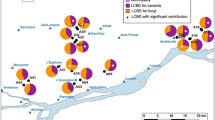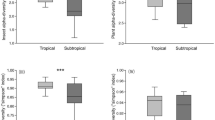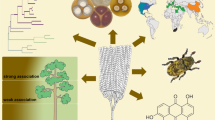Abstract
Eighty wood samples representing 51 taxa in 33 genera of Leguminosae were collected in the Sinnamary River Basin in Northern French Guiana and evaluated for their fauna of longhorned beetles (Cerambycidae) and their phytochemical constituents. The cerambycid fauna was assessed using cut branches and trunks that were continuously observed for emerging beetles. Phytochemical patterns were determined in partially purified methanolic extracts that were obtained from wood and bark of the same branches and trunks using thin-layer chromatography (TLC) and high-pressure liquid chromatography (HPLC). It was found that small groups of taxonomically related and often phytochemically similar plant species serve as host plants for small and well-defined longicorn guilds. Members of longicorn guilds are usually not taxonomically related. Host-plant chemistry appears to play a role in resource allocation among longicorn guilds in this lowland neotropical rainforest. These findings are discussed in reference to theories on coevolution and adaptive radiation in plant-insect associations.
Zusammenfassung
Insgesamt achtzig Holzproben, die im Becken des Sinnamary im nördlichen Französisch Guiana von 51 Taxa der Leguminosen entnommen wurden und insgesamt 33 Gattungen repräsentieren, wurden in Hinblick auf ihre Langhornkäferfauna (Cerambycidae) und ihre phytochemischen Eigenschaften untersucht. Gefällte Stämme wurden über die Dauer von vier Monaten hinweg beobachtet, um die schlüpfenden Langhornkäfer zu identifizieren. Die phytochemischen Profile wurden mittels Dünnschichtchromatographie (DC) und Hochdruckflüssigkeitschromatographie (HPLC) von methanolischen Extrakten charakterisiert, die von den Holzproben der frisch gefällten Stämmen angefertigt wurden. Die Resultate dieser Untersuchung zeigen, dass kleinere Gruppen taxonomisch verwandter und oft phytochemisch ähnlicher Leguminosenarten als Wirtspflanzen für kleine, aber gut beschreibbare Langhornkäfersippen dienen. Die Arten dieser Langhornkäfersippen zeigen oft keinerlei taxonomische Verwandtschaft. Daher kann angenommen werden, dass die phytochemischen Profile der Wirtspflanzen eine wichtige Rolle in der Nutzung und Erkennung von potentiellen Wirtspflanzen in diesem tiefliegenden Neotropischen Regenwald spielen. Diese Resultate werden im Hinblick auf die Theorien der Coevolution und der adaptiven Kolonisierung von Wirtspflanzen diskutiert.
Similar content being viewed by others
Literature Cited
Achenbach, H., M. Stöcker, &M. A. Constenla. 1986. Chemical investigations of tropical medicinal plants, XXI [1] Long chain alkyl esters of ferulic and p-coumaric acid fromBauhinia manca. Z. Na-turforsch. C41: 164–168.
Balandrin, M. F. &A. D. Kinghorn. 1981. Characterization of sweetinine, a constituent ofSweetia ele-gans, as theOrmosia alkaloid, (=)-6-epipodopetaline. J. Nat. Prod.44: 619–622.
Barneby, R. C. &J. W. Grimes. 1996. Silk tree, guanacaste, monkey’s earring: a generic system for the synandrous Mimosaceae of the Americas. Part I.Abarema, Albizia, and allies. Mem. New York Bot. Gard.74(1): 1–292.
——. 1997. Silk tree, guanacaste, monkey’s earring: a generic system for the synandrous Mimosaceae of the Americas. Part II.Pithecellobium, Cojoba, andZygia. Mem. New York Bot. Gard.74(2): 1–149.
- & -. Submitted. Flora of the Guianas: Leguminosae. Koeltz Scientific Books, Koenigstein.
Berenbaum, M. 1983. Coumarins and caterpillars: a case of coevolution. Evolution37: 163–179.
Bernays, E. &M. Graham. 1988. On the evolution of host specificity in phytophagous arthropods. Ecology69: 886–892.
Bisby, F. A., J. Buckingham &J. B. Harborne (eds.). 1994. Phytochemical dictionary of the Legumi-nosae, ILDIS (International Legume Database and Information Service) and CHCD (Chapman and Hall Database). Vols. 1 & 2. Chapman & Hall, London.
Borel, C. &K. Hostettmann. 1987. Molluscicidal saponins fromSwartzia madagascariensis Desvaux. Helv. Chim. Acta70: 570–576.
Bowers, D. 1988. Chemistry and coevolution: iridoid glycosides, plants and herbivorous insects. Pp. 133–165in K. Spencer (ed.), Chemical mediation of coevolution. Academic Press, San Diego.
Brown, K. S. 1987. Chemistry at the Solanaceae/Ithomiinae interface. Ann. Missouri Bot. Gard.74: 359–397.
—,J. R. Rigo, R. B. Francini, A. B. Barros de Morais &P. C. Motta. 1991. Aposematic insects on toxic host plants: coevolution, colonization, and chemical emancipation. Pp. 375–402in P. W. Price, T. M. Lewinsohn, G. W. Fernandes & W. W. Benson (eds.), Plant-animal interactions: evolu-tionary ecology in tropical and temperate regions. John Wiley, New York.
Cochran, D. G. 1995. Insect resistance to pyrethrins and pyrethroids. Pp. 234–248in J. E. Casida & G. B. Quistad (eds.), Pyrethrum flowers. Production, chemistry, toxicology, and uses. Oxford Univer-sity Press, New York.
Cronquist, A. 1981. An integrated system of classification of flowering plants. Columbia University Press, New York.
Drummond, B. A. &K. S. Brown. 1987. Ithomiinae (Lepidoptera: Nymphalidae): summary of known larval food plants. Ann. Missouri Bot. Gard.74: 341–358.
DuBois, J. L. &A. T. Sneden. 1992. Dihydrolicoisoflavone, a new isoflavanone fromSwartzia poly-phylla. J. Nat. Prod.58: 629–632.
Ehrlich, P. R. &P. H. Raven. 1964. Butterflies and plants: a study in coevolution. Evolution18: 586–608.
Farrell, B. &C. Mitter. 1990. Phylogenesis of insect/plant interactions: havePhyllobrotica leaf beetles (Chrysomelidae) and the Lamiales diversified in parallel? Evolution44: 1389–1403.
Fox, L. R. 1988. Diffuse coevolution with complex communities. Ecology69: 906–907.
Harborne, J. B. 1993. Introduction to ecological biochemistry. Ed. 4. Academic Press, London.
Hegnauer, R. 1994. Chemotaxonomie der Pflanzen. Band 11a. Leguminosae. Birkhäuser Verlag, Basel.
Hequet, V. &G. Tavakilian. 1996. Longicorns de Guyane. Silvolab, ORSTOM, Cayenne, France.
Kinghorn, A. D. &S. J. Smolenski. 1981. Alkaloids in the Papilionoideae. Pp. 585–598in R. M. Polhill & P. H. Raven (eds.), Advances in legume systematics. Parts 1 & 2. Royal Botanic Gardens, Kew.
Mendelsohn, R. &Balick, M. 1995. The value of undiscovered Pharmaceuticals in tropical forests. Econ. Bot.49: 223–228.
NAPRALERT. 1997. Natural PRoducts ALERT Database, Board of Trustees of the University of Illi-nois. Program for Collaborative Research in the Pharmaceutical Sciences, College of Pharmacy of the University of Illinois at Chicago.
Nigg, H. N. &R. C. Beier. 1995. Evaluation of food for potential toxicants. Pp. 192–201in D. L. Gustine & H. E. Flores (eds.), Phytochemicals and health. American Society of Plant Physiologists, Rockville, MD.
Polhill, R. M. &P. H. Raven (eds.). 1981. Advances in legume systematics. Parts 1 and 2. Royal Bo-tanic Gardens, Kew.
Renwick, J. A. A. 1988. Comparative mechanisms of host selection by insects attacking pine trees and crucifers. Pp. 303–316in K. Spencer (ed.), Chemical mediation of coevolution. Academic Press, San Diego.
Ricker, M., G. Veen, D. C. Daly, L. Witte, L. Sinta V., I. J. Chota &F. C. Czygan. 1994. Alkaloid di-versity in eleven species ofOrmosia and inClathrotropis macrocarpa (Leguminosae-Papilionoi-deae). Brittonia46: 355–371.
Schuler, M. A. 1996. The role of cytochrome P450 monooxygenases in plant-insect interactions. Pl. Physiol. 112: 1411–1419.
Tavakilian, G., A. Berkov, B. Meurer-Grimes &S. Mori. 1997. Neotropical tree species and their fau-nas of xylophagous longicorns (Coleoptera: Cerambycidae) in French Guiana. Bot. Rev. (Lancas-ter)63: 303–355.
Taylor, R. S. L., J. B. Hudson &G. H. N. Towers. 1995. Photo-mediated activities of antibacterial and antiviral compounds from plants. Pp. 48–58in D. L. Gustine & H. E. Flores (eds.), Phytochemicals and health. American Society of Plant Physiologists, Rockville, MD.
Thompson, J. 1988. Coevolution and alternative hypotheses on insect/plant interactions. Ecology 69: 893–895.
Author information
Authors and Affiliations
Rights and permissions
About this article
Cite this article
Meurer-Grimes, B., Tavakilian, G. Chemistry of cerambycid host plants. Part I: Survey of Leguminosae—A study in adaptive radiation. Bot. Rev 63, 356–394 (1997). https://doi.org/10.1007/BF02856597
Issue Date:
DOI: https://doi.org/10.1007/BF02856597




